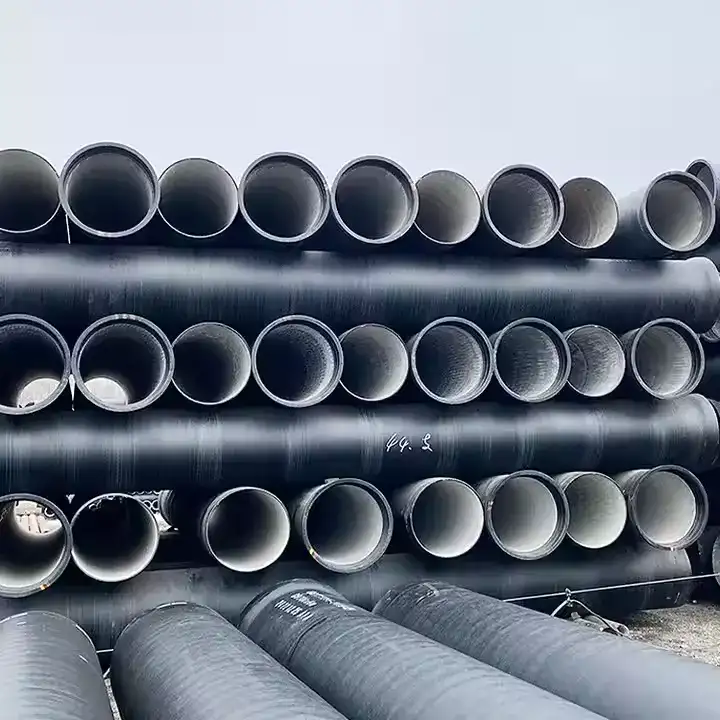Ductile iron pipe (DIP) is renowned for its long service life—typically 100 years or more when properly specified and installed. In benign soils or with modern corrosion-control measures (cement-mortar lining, polyethylene sleeving), life spans of 100–110 years are routinely achieved. In highly corrosive soils without protection, unlined pipes may last only 21–40 years; loose polyethylene encasement can restore performance to 100+ years, except in “uniquely severe” conditions where 37 years is typical. Factors such as soil resistivity, internal linings, external coatings, and maintenance practices all influence actual longevity, making DIP a cost-effective choice over its century-plus lifespan .

1. Expected Service Life by Condition
| Condition | Expected Lifespan |
|---|---|
| Unprotected in benign soils | ≥ 100 years |
| Unprotected in aggressive soils | 21 – 40 years |
| Cement-mortar lined (AWWA C104) | ~ 100 years |
| Loose polyethylene sleeving (AWWA C105 / ISO 8180) | ≥ 100 years |
| In uniquely severe soils, with LPS | ~ 37 years |
2. Key Factors Influencing Lifespan
2.1 Soil Corrosivity
Soil resistivity, pH, moisture and bacterial activity govern corrosion rates. Unprotected DIP in low-resistivity soils corrodes faster, often limiting service life to 21–40 years.
2.2 Internal Linings
Cement-mortar linings (per AWWA C104) create a physical barrier against internal corrosion, virtually eliminating tuberculation and extending life to 100 years or more.
2.3 External Coatings & Sleeving
Standard zinc, asphaltic paint or water-based coatings protect the exterior. Loose polyethylene sleeving (LPS) — the preferred US method since the 1950s — isolates DIP from corrosive soils, restoring lifespans to 100+ years.
2.4 Cathodic Protection
In exceptionally aggressive environments, cathodic protection systems paired with dielectric coatings can further slow corrosion, though results vary with installation quality and soil conditions.
3. Corrosion Rates & Comparative Data
Unlined DIP and buried mild steel corrode at similar rates under identical conditions. Lined DIP corrodes 2–5 times slower than unlined pipe, per recent laboratory studies. Over 50 years, DIP’s low maintenance requirement yields significant lifecycle savings compared to plastic alternatives.
4. Lifecycle Cost Perspective
Although initial material costs can exceed PVC or HDPE, DIP’s 100+ year service life and minimal replacement frequency produce lower total cost of ownership. A life-cycle analysis by US Pipe projects DIP’s cost per year of service to be competitive with or below that of plastic mains.
5. Best Practices for Maximizing Longevity
-
Site Evaluation: Test soil resistivity and chemistry to select appropriate protection.
-
Proper Installation: Avoid coating damage; follow handling guidelines for linings and sleeving.
-
Regular Inspection: Use CCTV, ultrasonic testing, or corrosion coupons to detect early deterioration.
-
Cathodic Monitoring: Where applied, monitor current flows to ensure system efficacy.
6. FAQ
Q1: What is the typical life expectancy of ductile iron pipe?
A1: When properly lined, sleeved and installed in benign soils, DIP reliably lasts 100–110 years.
Q2: How long will unprotected ductile iron pipe last?
A2: In aggressive soils without coatings or sleeving, expect only 21–40 years of service.
Q3: Does polyethylene sleeving really extend lifespan?
A3: Yes—loose polyethylene encasement can restore DIP to 100+ years of life, with proven performance in field tests.
Q4: Are there scenarios where DIP may fail sooner than 100 years?
A4: In “uniquely severe” corrosive conditions, even sleeved pipe may last only ~37 years without additional measures.
Q5: What maintenance steps help ensure a long service life?
A5: Conduct pre-installation soil analysis, follow installation best practices, inspect periodically, and maintain cathodic protection where used.

